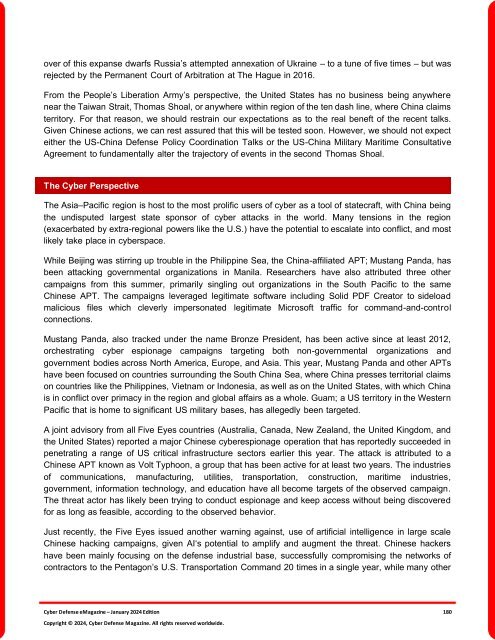The Cyber Defense eMagazine January Edition for 2024
Cyber Defense eMagazine January Edition for 2024 #CDM #CYBERDEFENSEMAG @CyberDefenseMag by @Miliefsky a world-renowned cyber security expert and the Publisher of Cyber Defense Magazine as part of the Cyber Defense Media Group as well as Yan Ross, Editor-in-Chief and many more writers, partners and supporters who make this an awesome publication! 201 page January Edition fully packed with some of our best content. Thank you all and to our readers! OSINT ROCKS! #CDM #CDMG #OSINT #CYBERSECURITY #INFOSEC #BEST #PRACTICES #TIPS #TECHNIQUES
Cyber Defense eMagazine January Edition for 2024 #CDM #CYBERDEFENSEMAG @CyberDefenseMag by @Miliefsky a world-renowned cyber security expert and the Publisher of Cyber Defense Magazine as part of the Cyber Defense Media Group as well as Yan Ross, Editor-in-Chief and many more writers, partners and supporters who make this an awesome publication! 201 page January Edition fully packed with some of our best content. Thank you all and to our readers! OSINT ROCKS! #CDM #CDMG #OSINT #CYBERSECURITY #INFOSEC #BEST #PRACTICES #TIPS #TECHNIQUES
You also want an ePaper? Increase the reach of your titles
YUMPU automatically turns print PDFs into web optimized ePapers that Google loves.
over of this expanse dwarfs Russia’s attempted annexation of Ukraine – to a tune of five times – but was<br />
rejected by the Permanent Court of Arbitration at <strong>The</strong> Hague in 2016.<br />
From the People’s Liberation Army’s perspective, the United States has no business being anywhere<br />
near the Taiwan Strait, Thomas Shoal, or anywhere within region of the ten dash line, where China claims<br />
territory. For that reason, we should restrain our expectations as to the real beneft of the recent talks.<br />
Given Chinese actions, we can rest assured that this will be tested soon. However, we should not expect<br />
either the US-China <strong>Defense</strong> Policy Coordination Talks or the US-China Military Maritime Consultative<br />
Agreement to fundamentally alter the trajectory of events in the second Thomas Shoal.<br />
<strong>The</strong> <strong>Cyber</strong> Perspective<br />
<strong>The</strong> Asia–Pacific region is host to the most prolific users of cyber as a tool of statecraft, with China being<br />
the undisputed largest state sponsor of cyber attacks in the world. Many tensions in the region<br />
(exacerbated by extra-regional powers like the U.S.) have the potential to escalate into conflict, and most<br />
likely take place in cyberspace.<br />
While Beijing was stirring up trouble in the Philippine Sea, the China-affiliated APT; Mustang Panda, has<br />
been attacking governmental organizations in Manila. Researchers have also attributed three other<br />
campaigns from this summer, primarily singling out organizations in the South Pacific to the same<br />
Chinese APT. <strong>The</strong> campaigns leveraged legitimate software including Solid PDF Creator to sideload<br />
malicious files which cleverly impersonated legitimate Microsoft traffic <strong>for</strong> command-and-control<br />
connections.<br />
Mustang Panda, also tracked under the name Bronze President, has been active since at least 2012,<br />
orchestrating cyber espionage campaigns targeting both non-governmental organizations and<br />
government bodies across North America, Europe, and Asia. This year, Mustang Panda and other APTs<br />
have been focused on countries surrounding the South China Sea, where China presses territorial claims<br />
on countries like the Philippines, Vietnam or Indonesia, as well as on the United States, with which China<br />
is in conflict over primacy in the region and global affairs as a whole. Guam; a US territory in the Western<br />
Pacific that is home to significant US military bases, has allegedly been targeted.<br />
A joint advisory from all Five Eyes countries (Australia, Canada, New Zealand, the United Kingdom, and<br />
the United States) reported a major Chinese cyberespionage operation that has reportedly succeeded in<br />
penetrating a range of US critical infrastructure sectors earlier this year. <strong>The</strong> attack is attributed to a<br />
Chinese APT known as Volt Typhoon, a group that has been active <strong>for</strong> at least two years. <strong>The</strong> industries<br />
of communications, manufacturing, utilities, transportation, construction, maritime industries,<br />
government, in<strong>for</strong>mation technology, and education have all become targets of the observed campaign.<br />
<strong>The</strong> threat actor has likely been trying to conduct espionage and keep access without being discovered<br />
<strong>for</strong> as long as feasible, according to the observed behavior.<br />
Just recently, the Five Eyes issued another warning against, use of artificial intelligence in large scale<br />
Chinese hacking campaigns, given AI‘s potential to amplify and augment the threat. Chinese hackers<br />
have been mainly focusing on the defense industrial base, successfully compromising the networks of<br />
contractors to the Pentagon’s U.S. Transportation Command 20 times in a single year, while many other<br />
<strong>Cyber</strong> <strong>Defense</strong> <strong>eMagazine</strong> – <strong>January</strong> <strong>2024</strong> <strong>Edition</strong> 180<br />
Copyright © <strong>2024</strong>, <strong>Cyber</strong> <strong>Defense</strong> Magazine. All rights reserved worldwide.

















